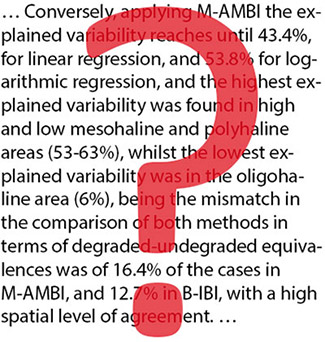Four steps to preparing your first draft
Here is the process I use:
- Think about the topic you want to present, for some days or weeks.
- Make figures and tables.
- Then write as quickly as possible, as if thinking out loud. Get everything down, ignoring spelling, grammar, style and troublesome words.
- Correct and rewrite only when the whole text is on paper.
Do not split the manuscript among the co-authors. It is better to write a first complete draft, and then the co-authors can amend and add new text. In this way, the internal coherence of the paper is ensured. Ask each reviewer to track their changes.
Polishing your manuscript
Use good English
Unfortunately for non-native English speakers, language is an important problem. If the language prevents reviewers from understanding the scientific content of your work, the possibility of acceptance will be lowered greatly.
At the minimum, you should use the best English you can manage in presenting your high-quality science. Get a skilled writer or someone fluent in English to check your manuscript before submission. Now, most publishers have a service of English correction with a cost around €250 ($285) per paper.
You must save your readers the trouble of guessing what you mean. Look at this complaint from an editor:
“(This) paper fell well below my threshold. I refuse to spend time trying to understand what the author is trying to say. Besides, I really want to send a message that they can’t submit garbage to us and expect us to fix it. My rule of thumb is that if there are more than 6 grammatical errors in the abstract, then I don’t waste my time carefully reading the rest.”
Write with clarity, objectivity, accuracy and brevity, presenting your scientific research in a way that is logical and understandable. To improve your language skills, you can practice reading and writing English in other parts of your work, for example, by keeping records in English during your research and reading as many papers as you can in English.
Avoid these common problems:
- Sentences that don’t follow each other logically
- Sentences that are difficult to understand by non-initiated readers (e.g., “The Annex IV of the MSFD includes the definition of GES to be applied by MS.”
- Grammatical errors
- Spelling mistakes and typos
Simplify your language
- Original: “Numerous studies in recent years, such as those by Miller (1995) and Smith (1998), have shown that low salinities enhance oyster recruitment.”
- Suggested: “Low salinities enhance oyster recruitment (Miller, 1995; Smith 1998).”
Avoid long sentences
- Direct and short sentences are preferred!
- Long sentences do not make the writing more professional; they only confuse readers.
- Nowadays, the average length of sentences in scientific writing is about 12 to 17 words.
- It is said that we read one sentence in one breath. Long sentences choke readers.
Some languages (e.g., Spanish) tend to have long and complicated sentences, which can be expressed with fewer words in English. You have to change your style when writing in English. One idea or piece of information per sentence is sufficient. Avoid multiple statements in one sentence. In writing the following passage some years ago, I understood my science well – but with 78 words in a single sentence, it’s unlikely that anyone would have understood it.
“… Conversely, applying M-AMBI the explained variability reaches until 43.4%, for linear regression, and 53.8% for logarithmic regression, and the highest explained variability was found in high and low mesohaline and polyhaline areas (53-63%), whilst the lowest explained variability was in the oligohaline area (6%), being the mismatch in the comparison of both methods in terms of degraded-undegraded equivalences was of 16.4% of the cases in M-AMBI, and 12.7% in B-IBI, with a high spatial level of agreement.”
After the reviewers recommended using shorter sentences, I modified it to the following:
“… Conversely, applying M-AMBI the explained variability reaches until 43.4%, for linear regression, and 53.8% for logarithmic regression. The highest explained variability was found in high and low mesohaline and polyhaline areas (53-63%). In turn, the lowest explained variability was in the oligohaline area (6%). The mismatch in the comparison of both methods in terms of degraded-undegraded equivalences was of 16.4% of the cases in M-AMBI, and 12.7% in B-IBI, with a high spatial level of agreement.“
Problems with long sentences:
- Use of passive voice (e.g., “It has been found that there had been many …” instead of “Researchers found that many …”)
- Poor sentence structure with incorrect conjunctions or dangling modifiers (e.g., “because …, so …”; “Although …, but …”; “considering …, it is …”). For example, avoid this kind of sentence: “The highest explained variability was found in high and low mesohaline and polyhaline areas (53-63%), because of the high concentration of organic matter, although it was …” It is better to say: “The highest explained variability was found in high and low mesohaline and polyhaline areas (53-63%). This is related to the high concentration of organic matter. Although it was…”
- Excessive use of subordinate clauses in one sentence (e.g., “It has already been found that when salinity increases to the mouth of an estuary there would be higher benthic richness, which can result also in higher diversity, while in low salinity areas benthic richness tends to be low …”)
- Mixing different levels of parallelisms connected by “and” in one sentence (e.g., “This research investigates the grain size of sediments in coastal areas and discusses the grain size and the coastal sedimentation based on grain size …”)
Length of the manuscript
Again, look at the journal’s Guide for Authors, but an ideal length for a manuscript is 25 to 40 pages, double spaced, including essential data only. Here are some general guidelines:
- Title: Short and informative
- Abstract: 1 paragraph (<250 words)
- Introduction: 1.5-2 pages
- Methods: 2-3 pages
- Results: 6-8 pages
- Discussion: 4-6 pages
- Conclusion: 1 paragraph
- Figures: 6-8 (one per page)
- Tables: 1-3 (one per page)
- References: 20-50 papers (2-4 pages)
Redundancies to avoid:
- Overusing conjunctive words or phrases such as “However,” “In addition,” “Moreover.” Use these words sparingly.
- Phrases without meaning. Learn from the following comments from an Editor: “Never say ‘and references therein.’ … Any intelligent reader knows to look at the references in a paper in order to get even more information.” Delete “In present paper.” It is impossible for it to be in a different paper! You start the conclusions “In this paper, we have prepared…..” This is nonsense. The samples were prepared in the laboratory!
- Repetitive words with similar meanings, such as “schematic diagram,” “research work,” etc. It’s better to use the words separately: “this scheme,” “that diagram,” “the research was …,” “the work done was …”
Other writing don’ts:
- Passive voice for intransitive verbs (which do not have a direct object); only transitive verbs can have passive forms. Hence, you cannot say: “are happened” or “was went.”
- The third-person singular form of verbs used for plural subjects (e.g., “the concentrations shows that …” instead of “the concentrations show that …”
- Dangling modifiers, in which the subject of the main clause is not the doer (e.g., “To improve the results, the experiment was done again.” The experiment cannot improve the results itself. It should be “We did the experiment again to improve the results.”)
- Don’t use spoken abbreviations: “it’s,” “weren’t,” “hasn’t.”
- Never begin a sentence with a numeral: “5 mg of sediment were analysed …” Use: “Sediment (5 mg) was analysed …”
- Single-digit numbers should be spelled out; numbers of two or more digits should be expressed as numerals (you can write “four samples” or “25 samples”). In a sentence containing a series of numbers, at least one of which is more than one digit, all of the numbers should be expressed as numerals. (Of the 21 samples, 1 was muddy, 6 gravel, and 14 sandy.)
To make the reviewer’s life easier;
- Keep the text and layout style consistent throughout the manuscript by using the same font (usually Times New Roman) and font size in the text, figures and tables. Double line spacing and 12-point font is preferred; this makes more convenient for reviewers to make annotations. Margins of 3 cm are also useful for reviewers.
- Number all pages! This is very important because it helps reviewers show you the parts to be amended.
- Number each row in the text (it is easier to identify the position of the comments from the reviewers).
- Pay attention to the abbreviations; they should be defined on the first use in both abstract and the main text (also in the legends of figures and tables). Some journals even forbid the usage of abbreviations in the abstract. Refer to the journal’s Guide for Authors to see the requirements for abbreviations.







Leave a Reply